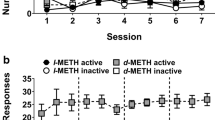Abstract
The observation that a particular drug state may acquire the properties of a discriminative stimulus is explicable on the basis of drug-induced interoceptive cues. The present investigation sought to determine (a) whether the hallucinogens mescaline and LSD could serve as discriminative stimuli when either drug is paired with saline and (b) whether discriminative responding would occur when the paired stimuli are produced by equivalent doses of LSD and mescaline. In a standard two-lever operant test chamber, rats received a reinforcer (sweetened milk) for correct responses according to a variable interval schedule. All sessions were preceded by one of two treatments; following treatment A, only responses on lever A were reinforced and, in a similar fashion, lever B was correct following treatment B. No responses were reinforced during the first five minutes of a daily thirty-minute session. It was found that mescaline and LSD can serve as discriminative stimuli when either drug is paired with saline and that the degree of discrimination varies with drug dose. When equivalent doses of the two drugs were given to the same animal, no discriminated responding was observed. The latter finding suggests that mescaline and LSD produce qualitatively similar interoceptive cues in the rat.
Similar content being viewed by others
References
Barry, H., Etheredge, E. E., Miller, N. E.: Counterconditioning and extinction of fear fail to transfer from amobarbital to nondrug state. Psychopharmacologia (Berl.) 8, 160–156 (1965).
Conger, J. J.: The effect of alcohol on conflict behavior in the albino rat. Quart. J. Stud. Alcohol. 12, 1–29 (1951).
Goldstein, A.: Biostatistics: An Introductory Text. New York: MacMillan 1964.
Hollister, L. E.: Chemical psychoses. Springfield, Ill.: Ch. C. Thomas 1968.
Kelleher, R. T., Morse, W. H.: Behavioral pharmacology. In Reviews of Physiology, Biochemistry and Experimental Pharmacology. Vol. 60, pp. 1–56. Berlin-Heidelberg-New York: Springer 1968.
Kubena, R. T., Barry, H.: Two procedures for training differential responses in alcohol and nondrug conditions. J. Pharm. Sci. 58, 99–101 (1969).
Overton, D. A.: State dependent learning produced by depressant and atropinelike drugs. Psychopharmacologia (Berl.) 10, 6–31 (1966).
—: Dissociated learning in drug states (state dependent learning). In: Psychopharmacology, A Review of Progress, 1957–1967, pp. 918–930. D. H. Efron, ed. Washington: U. S. Government Printing Office 1968a.
—: Visual cues and shock sensitivity in the control of T maze choice by drug conditions. J. comp. Psychol. 66, 216–219 (1968b).
Stewart, J.: Differential responses based on the physiological consequences of pharmacological agents. Psychopharmacologia (Berl.) 3, 132–138 (1962).
Wilcoxin, F., Wilcox, R. A.: Some rapid approximate statistical procedures. Pearl River: Lederle Laboratories 1964.
Author information
Authors and Affiliations
Additional information
Supported in part by Graduate Training Grant 2-T01-GM 00107 from the Division of Medical Sciences, National Institutes of Health and in part by Grant MH 15406 from the National Institute of Mental Health.
Rights and permissions
About this article
Cite this article
Hirschhorn, I.D., Winter, J.C. Mescaline and lysergic acid diethylamide (LSD) as discriminative stimuli. Psychopharmacologia 22, 64–71 (1971). https://doi.org/10.1007/BF00401468
Received:
Revised:
Issue Date:
DOI: https://doi.org/10.1007/BF00401468




